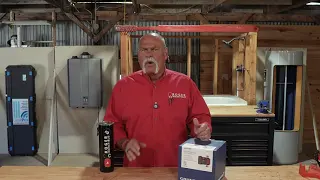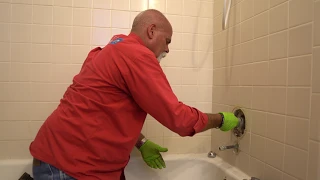Why Do Cast Iron Sewer Lines Fail?
Aging Infrastructure
Cast iron used to be the gold standard for drain, waste, and vent systems in older homes. Typically, cast iron might last 30 to 40 years under optimal conditions. Over time, however, it corrodes from the inside out—especially when exposed to acidic waste or shifting soils. As the bottom of the pipe rusts away, sewage and water begin seeping into the soil beneath the slab.
Chemical Reaction and Corrosion
Inside the pipe, bacteria and chemical byproducts create an acidic environment. From the outside, soil conditions and moisture can accelerate oxidation. Eventually, small pinholes develop, which grow into full-blown cracks or open channels. Once that happens, you have an ongoing leak that can undermine your foundation and saturate the ground below.
Slow, Costly Symptoms
Homeowners might initially notice slow drains, unusual smells, or damp spots around the foundation. By the time a plumber is called, the pipes may already be severely compromised. Cast iron typically fails across multiple horizontal runs. Occasionally, even the vertical stacks (where the pipes exit through the roof) corrode near floor penetrations. That means a thorough solution often involves major demolition or tunneling to access the entire system.
The $100,000 Residential Sewer Job
Scope of Work
The job highlighted in the video started with a standard assessment: poor drainage, persistent odor, possible floor damage. Once the plumber inspected the lines—often using cameras and specialized testing—he found that the pipe was missing entire bottoms and sides. Every horizontal run needed to be replaced, from bathroom drains to kitchen lines. Additionally, some vertical risers were broken at the point where they pierced the floor. The homeowner was left with limited choices: let the problem worsen or invest in a total replacement.
Why the High Cost?
- Tunnels and Safety: The plumber had to dig extensive tunnels under the foundation to replace and reroute pipe. Each tunnel must be large enough for a professional to move safely without risking cave-ins. Tunnels might extend hundreds of feet to reach every fixture group in the house.
- Penetrations Through the Slab: In some areas, the plumber needs to chip out around the vertical pipes inside the home. That means carefully removing tile, wood, or other floor materials, then breaking concrete.
- Material Upgrade: Gone is the old cast iron, replaced with modern PVC lines, which require additional hangers, standoff clamps, or all-thread rods to secure them overhead in the tunnels.
- Manpower and Time: A job of this scale might tie up a dig crew and licensed plumbers for weeks—sometimes longer. The plumber must also coordinate with inspectors, city permits, and engineer approvals if the foundation is heavily compromised.
The Customer Conversation
Telling a homeowner their sewer repair will cost six figures is never easy. But as Robert Renfro points out in the video, you have to weigh the consequences of not fixing it. The property itself might be worth $1 million or more—leaving a rotting sewer system might devastate the structure, degrade indoor air quality, and lower the property’s value. That $100,000 repair, in comparison, becomes a necessary investment to protect a far more valuable asset.
Going Underground: The Tunneling Approach
Why Tunnel Instead of Jackhammering Everywhere?
In some parts of the country, the standard approach is to cut open floors in each room to replace pipe. In Texas, where the video is based, the clay soil beneath the slab can be stable enough to tunnel safely. Tunneling also keeps the interior of the home relatively intact. While some vertical penetrations may still be needed, most of the work remains underground.
Safety Is Paramount
Plumbers die each year from cave-ins or poorly supported soil. The key to safe tunneling is removing all the dirt up to the slab so there’s no loose “ceiling” that can collapse. Typically, a 4-foot-wide tunnel is carved, and the top is entirely the underside of the concrete slab. Proper venting, lighting, and exit points must be arranged to keep workers safe.
Uncovering All the Piping
Since the plan is a full replacement, the crew systematically digs around every run of pipe. This thorough exposure ensures no hidden branch lines remain corroded. They can also lay out the new pipe along the same route or slightly reroute it for better slope or connection angles.
Replacing the System: Cast Iron Out, PVC In
Why PVC Over New Cast Iron?
While modern cast iron is better than older formulations, it’s still prone to certain corrosion issues—especially if water quality is poor. PVC is lightweight, corrosion-resistant, and simpler to install once you have access to the entire line. Some codes even prefer or require PVC for replacement, depending on local regulations.
Securing the Pipe Properly
With open tunnels, the plumber can hang PVC from the slab using stainless-steel or galvanized all-thread rods and clevis hangers. This ensures perfect slope, minimal stress on fittings, and prevents sags that might otherwise collect debris. In the video, Renfro mentions installing “stand-off clamps and all-thread,” making each pipe run neat, secure, and long-lasting.
Vent and Fixture Tie-Ins
Every fixture—sinks, bathtubs, showers, toilets—connects to these new lines. Where the vent system meets the drain, the plumber must ensure each fixture is properly vented. If the old cast iron risers are also in bad shape, they’ll chop out and replace them near the floor or even up the walls, if necessary.
The Role of Leak Detection: Why Mastering It Matters
Sponsored by Leak Pro
The video is sponsored by Leak Pro, emphasizing the value of advanced leak detection training. While cast iron failures often manifest visually (a missing bottom in the pipe, for instance), water-line leaks can be stealthier. Tools like electronic listening devices or helium detection become invaluable. Skilled leak detection means more than just fancy gadgets:
- Isolating Water vs. Sewer: Not all slab issues are sewer-based. Some are water-pressure leaks. A plumber who can do both is an asset to homeowners.
- Pinpointing the Source: The difference between a half-day repair and a multi-day fiasco can hinge on accurately locating the break.
- Complete Service: If you can locate the leak and fix it in-house, you retain that revenue. Passing it to an outside specialist means lost profit and scheduling hassles.
Profit Potential
As Renfro points out, major leak detection and repair is “where the good money is” in residential plumbing these days. With aging infrastructure, more homeowners face catastrophic pipe failures. Plumbers who shy away from slab leaks and advanced diagnostics leave money on the table. If you’re a plumbing company owner, consider investing in training—like that from Leak Pro—to equip your team for high-level jobs.
Presenting Options and Building Trust
Multiple Solutions
When faced with a failing sewer line or a suspected leak, the homeowner needs clear, professional advice. Skilled plumbers typically present options:
- Full Replacement: The costliest but most permanent fix.
- Spot Repair: Potentially cheaper initially, but if the rest of the system is just as corroded, more breaks are likely.
- Do Nothing: Arguably the worst choice, but it’s still an option. The plumber explains potential damages, from foundation sinkage to ongoing sewage exposure.
Justifying a $100,000 Quote
Transparent breakdowns help. Show photos or videos of the rotted pipe. Provide a project timeline detailing the dig crew’s labor, materials, safety measures, and finishing steps. Emphasize the cost of not doing the job—foundation repairs, mold remediation, or lost property value could exceed $100,000 if neglected.
Add-Ons: Water Treatment or Repiping
Corroding water lines may be next. If the property has older galvanized piping or a poor water supply with high mineral content, propose a full repipe with PEX or copper. Include a water softener or filtration system. This forward-thinking approach can prevent future emergencies—and it’s a win-win for both the homeowner (fewer disruptions) and the company (increased revenue, better reputation).
Larger Lessons for Plumbers
Become a Leak Detection Expert
Mastering advanced slab-leak location sets you apart from competing shops. Instead of waiting on third-party locators, you can handle everything in-house—from diagnosis to final backfill. Tools like the Leak Pro system enhance your reputation for speed and accuracy.
Safety and Quality
When you dig massive tunnels, follow strict safety protocols. Always remove dirt up to the slab, maintain adequate entry/exit points, and use proper lighting. For new piping, use top-quality materials (stainless-steel rods, PVC support clamps) to ensure longevity.
Service Over Sales
Rob Renfro underscores that it’s all about the customer. Protective plastic sheeting, minimal intrusion, thorough daily cleanup—these details turn a $100,000 nightmare into a more tolerable experience. Communication about timelines and daily progress helps reduce stress for the homeowner.
Scale Your Services
If you run a plumbing company, big re-pipe or sewer replacement jobs can double or triple your annual revenue. But only if you have the technicians trained for slab leaks, the resources for major excavation, and the administrative side (permits, inspections, scheduling) in order. Use real-world success stories—like the $100,000 cast iron replacement—to market your advanced capabilities.
Conclusion
A $100,000 plumbing job might sound unbelievable to anyone accustomed to minor faucet fixes. Yet it’s a reality in many older homes where cast iron sewers have decayed beyond repair. In the video “$100,000 Plumbing Job,” Roger Wakefield and Robert Renfro illustrate exactly how these massive projects unfold—from diagnosing severe under-slab pipe failure to orchestrating the careful removal and replacement of every corroded run.
The lesson for homeowners? Addressing a failing sewer system is non-negotiable. Delaying the fix only magnifies damage to the foundation and poses health risks. The lesson for plumbers? Specializing in leak detection and major replacements can be extremely lucrative—but it demands expertise, safety measures, and impeccable customer service. Whether it’s sewer or water lines, learning advanced diagnostics and offering full-spectrum repair sets you up for the biggest projects in residential service plumbing.




